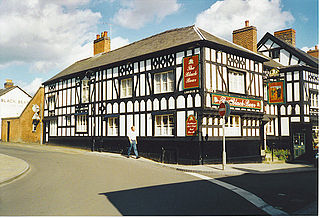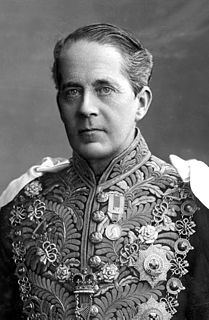
The Old Rectory is a grade II listed house in Old Church Street, Chelsea, London.

The Old Rectory is a grade II listed house in Old Church Street, Chelsea, London.

The current house mostly dates to about 1725, the early Georgian period, but the site itself was given by the Marquis of Winchester in 1566. [1] The Old Rectory has two acres of gardens, the largest private garden in London apart from Buckingham Palace and Witanhurst. [2] [3]

It was formerly home to the rector of Chelsea parish church, which was Chelsea Old Church, which dates from 1157, until the larger St Luke's Church, Chelsea was consecrated in 1824, when the rector from 1805 to 1832 was George Valerian Wellesley, brother of the Duke of Wellington. [2] [4]
From 1824 to 1830, Henry Blunt was George Wellesley's curate, then became the first rector of Trinity Church in Sloane Street, but turned down the post of rector of St Luke's offered to him by Lord Cadogan. [5]
Other notable rectors have included Charles Kingsley Sr (rector from 1836 to 1860), father of Charles Kingsley author of The Water Babies , and Henry Blunt's son [6] Gerald Blunt, father of Chelsea historian Reginald Blunt. [2] [4]
From 1990 to 1994, it was refurbished under the supervision of the South African developers Collett and Champion (Anthony Collett and David Champion), with funding provided by the Japanese businessman, Norikazu Nemoto, with all three being directors of Toyoko Metropolitan Company (TMC). [3] [7] Two "huge wings" were added, with ten bedroom suites and a "massive ballroom". [8] It was being marketed at around £25 million, and they were also developing the next-door 58 Old Church Street. [3] In February 1995, it sold for £22 million to Greek shipping magnate Theodore Angelopoulos, and was for many years London's largest and most expensive property sale in the UK. [9]
In 2001, Norwegian shipping magnate John Fredriksen bought the property for £37 million. [8] [10] [11] In 2004, it was reported in The Evening Standard that Roman Abramovich had offered £100 million for the 30,000 square feet house even though it was not for sale. [8] In 2012, The Washington Post reported the property was "worth US$172 million". [11] In 2015, The Tatler included the Old Rectory in their list of "The best private ballrooms". [12] Country Life reported the house discreetly listed in 2020. [13]
The rectory has had the following rectors since it has been at its present location: [1]

Knightsbridge is a residential and retail district in central London, south of Hyde Park. It is identified in the London Plan as one of two international retail centres in London, alongside the West End.

Chelsea is an affluent area in west London, England, due south-west of Charing Cross by approximately 2.5 miles. It lies on the north bank of the River Thames and for postal purposes is part of the south-western postal area.

Whitchurch is a market town in the north of Shropshire, England. It lies 2 miles (3 km) east of the Welsh border, 2 miles south of the Cheshire border, 20 miles (30 km) north of the county town of Shrewsbury, 20 miles (30 km) south of Chester, and 15 miles (24 km) east of Wrexham. At the 2011 Census, the population of the town was 9,781. Whitchurch is the oldest continuously inhabited town in Shropshire. Notable people who have lived in Whitchurch include the composer Sir Edward German, and illustrator Randolph Caldecott.

The Metropolitan Borough of Chelsea was a metropolitan borough of the County of London between 1900 and 1965. It was created by the London Government Act 1899 from most of the ancient parish of Chelsea. It was amalgamated in 1965 under the London Government Act 1963, with the Royal Borough of Kensington to form the Royal Borough of Kensington and Chelsea.

Sloane Square is a small hard-landscaped square on the boundaries of the central London districts of Belgravia and Chelsea, located 1.8 miles (2.9 km) southwest of Charing Cross, in the Royal Borough of Kensington and Chelsea. The area forms a boundary between the two largest aristocratic estates in London, the Grosvenor Estate and the Cadogan. The square was formerly known as 'Hans Town', laid out in 1771 to a plan of by Henry Holland Snr. and Henry Holland Jnr. Both the square and Hans Town were named after Sir Hans Sloane (1660–1753), an Anglo-Irish doctor who, jointly with his appointed trustees, owned the land at the time.

George Henry Cadogan, 5th Earl Cadogan, styled Viscount Chelsea from 1864 to 1873, was a British Conservative politician.

Cromhall is a village in South Gloucestershire, England. It is located between Bagstone and Charfield on the B4058, and also borders Leyhill. The parish population taken at the 2011 census was 1,231.

Old Church Street is a street in London, England in the Royal Borough of Kensington and Chelsea.

The Church of the Holy Trinity is an historic Episcopal church at 381 Main Street in Middletown, Connecticut. Completed in 1874, it is one of the city's finest examples of Gothic Revival architecture. Its nearby former rectory, also known as the Bishop Acheson House, is one of its finest Colonial Revival houses. The two buildings were listed on the National Register of Historic Places in 1979.

Cadogan Group Limited and its subsidiaries, including Cadogan Estates Limited, are British property investment and management companies that are owned by the Cadogan family, one of the richest families in the United Kingdom, which also holds the titles of Earl Cadogan and Viscount Chelsea, the latter used as a courtesy title by the Earl's eldest son. The Cadogan Group is the main landlord in the west London districts of Chelsea and Knightsbridge, and it is now the second largest of the surviving aristocratic Freehold Estates in Central London, after the Duke of Westminster's Grosvenor Estate, to which it is adjacent, covering Mayfair and Belgravia.

The Church of the Holy and Undivided Trinity with Saint Jude, Upper Chelsea, commonly called Holy Trinity Sloane Street or Holy Trinity Sloane Square, is a Church of England parish church in London, England. It was built in 1888–90 at the south-eastern side of Sloane Street, to a striking Arts and Crafts design, by the architect John Dando Sedding, and paid for by 5th Earl Cadogan, in whose London estate it lay. It replaced an earlier building only half its size which, at the time of its demolition, was less than 60 years old.
Chelsea College was a polemical college founded in London in 1609. This establishment was intended to centralize controversial writing against Catholicism, and was the idea of Matthew Sutcliffe, Dean of Exeter, who was the first Provost. After his death in 1629 it declined as an institution.
General Charles Cadogan, 2nd Baron Cadogan was an Anglo-Irish peer, soldier and Whig politician.

Monk Street is an historic street in the town of Monmouth, Monmouthshire, Wales. A portion of it was in existence by the 14th century, and appears on the 1610 map of the town by cartographer John Speed. It runs in a north-south direction, extending northward from its intersection with Whitecross Street. The name of the street relates to the nearby Priory, as well as the gate which was originally on this road and provided part of the town's defences, Monk's Gate. Monk Street is lined with numerous listed buildings.

The Parish Church of St Luke, Chelsea, is an Anglican church, on Sydney Street, Chelsea, London SW3, just off the King's Road. Ecclesiastically it is in the Deanery of Chelsea, part of the Diocese of London. It was designed by James Savage in 1819 and is of architectural significance as one of the earliest Gothic Revival churches in London, perhaps the earliest to be a complete new construction. St Luke's is one of the first group of Commissioners' churches, having received a grant of £8,333 towards its construction with money voted by Parliament as a result of the Church Building Act of 1818. The church is recorded in the National Heritage List for England as a designated Grade I listed building. The gardens of St Luke's are Grade II listed on the Register of Historic Parks and Gardens.

St Matthew's Anglican Church is a heritage-listed church at Beatrice Street, Drayton, once a town but now a suburb of Toowoomba in Toowoomba Region, Queensland, Australia. It was designed by James Marks and built from 1886 to 1887 by Seath, Hobart and Watson. It is also known as St Matthew's Church of England and is the second church of that name in Drayton. It was added to the Queensland Heritage Register on 21 October 1992.
Henry Blunt (1794–1843) was an evangelical cleric of the Church of England. He introduced an early parish magazine, Poor Churchman's Evening Companion, in his London parish of Chelsea.
Lieutenant-Colonel the Honorable Henry Cadogan was a British Army officer who served and died during the Peninsular War.
Charlotte Sloane Paget, Marchioness of Anglesey, formerly known as Lady Charlotte Wellesley, was the second wife of Henry Paget, 1st Marquess of Anglesey.

Christ Church, Marylebone, also called Christ Church, Lisson Grove, and Christ Church, Cosway Street, is a Grade II* listed former Church of England church, built in the 1820s in Marylebone in the City of Westminster to designs by Thomas and Philip Hardwick.